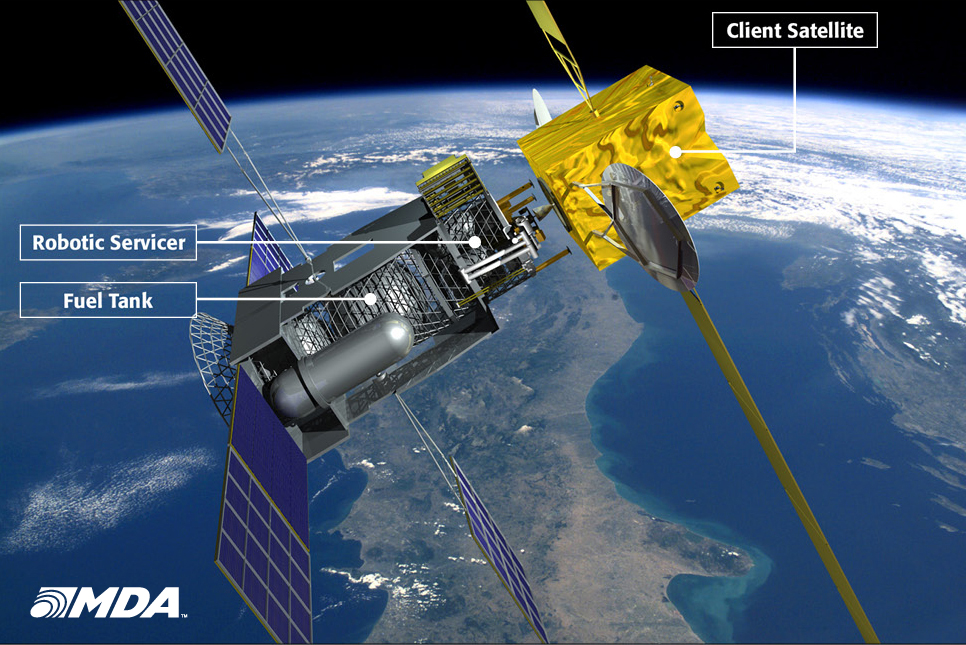World's First Space Gas Station for Satellites to Launch in 2015

Two satellite companies have announced a new deal to launch the first spacecraft designed to refuel other satellites in orbit.
The refueling craft – a flying satellite gas station – will be built by the Canadian company MacDonald, Dettwiler and Associates Ltd. (MDA) and is slated to launch in 2015. Communications satellite company Intelsat, based in Luxembourg and Washington, has signed on as its first client, agreeing to pay more than $280 million over time for its satellites to be refueled. [Video: How the Refueling Satellite Will Work]
Until now, satellites orbiting around Earth have been limited by how much fuel they carry onboard. Once those tanks run dry, the satellites die, sometimes languishing in space as uncontrollable debris that then poses the risk of colliding with other spacecraft.
The new plan offers the potential not just to extend the lives of working satellites, but to help combat the growing space junk problem. The satellite, called the Space Infrastructure Servicing (SIS) vehicle, is designed not just to transfer more fuel into existing satellites, but to inspect, tow, reposition and make minor repairs to them.
In addition to its tank of fuel, the refueling satellite will carry a robotic arm that can be used to grab onto satellites and tug at stuck solar array panels, for example, or attempt other minor fixes to broken parts.
"This is a first-time-ever, huge, huge, huge event," said Andrew Palowitch, director of the Space Protection Program, a joint project of U.S. Air Force Space Command and the National Reconnaissance Office, speaking at a National Research Council workshop on orbital debrislast week.
Palowitch stressed that the ability to tow or refuel dead satellites in order to steer them out of the way would have a big impact on the growing problem of dangerous space debris clogging the crowded corridors of Earth orbit. [Worst Space Debris Events of All Time]
Get the Space.com Newsletter
Breaking space news, the latest updates on rocket launches, skywatching events and more!
"In the context of debris removal, this is the absolute best and absolute most fantastic new venture for the entire space community," he said.
The refueling satellite will be able to move dead spacecraft to what's called the "graveyard orbit," where they are high enough that they should not pose a risk to working satellites, or maneuver them low enough that they break apart in Earth's atmosphere.
However, the primary benefit of the new satellite will be to extend the lives of other spacecraft that are still functioning fine, but are running low on fuel. This could save satellite operators from the significant costs of building and launching new satellites as often, project officials said.
"The way we look at it is, the best satellite you can have is the one that's already up there," Steve Oldham, vice president for satellite missions at MDA, told SPACE.com. "For the first time satellite operators and satellite users will have the choice of extending the lives of satellites. I think it can have a significant impact."
The concept of in-space refueling has been demonstrated before. In 2007 the U.S. Defense Advanced Research Projects Agency (DARPA) launched the Orbital Express mission, which saw two robotic spacecraft meet up and transfer fuel on orbit. MDA built the spacecraft robotic arm for Orbital Express.
The refueling craft is designed to meet up with a client's satellite in orbit and connect with the target's launch ring adapter – a piece of hardware that Oldham said about three-quarters of the satellites in that orbit have onboard. So it should be compatible with a large majority of the satellites working today.
MDA officials estimate it will take around 3 1/2 to 4 years to build the new satellite. The company plans to launch the satellite by 2015 and place it near geostationary orbit about 22,369 miles (36,000 kilometers) above Earth, where many commercial satellites reside.
In addition to Intelsat, MDA plans to court numerous commercial and government clients. Oldham said he anticipates widespread demand for the refueling satellite's services.
The satellite insurance industry, which must pay out funds to insured companies when their satellites fail, may also look to the new MDA satellite to attempt repairs on satellite that would otherwise represent a huge financial loss, company officials said.
You can follow SPACE.com senior writer Clara Moskowitz on Twitter @ClaraMoskowitz. SPACE.com for the latest in space science and exploration news on Twitter @Spacedotcom and on Facebook.
Join our Space Forums to keep talking space on the latest missions, night sky and more! And if you have a news tip, correction or comment, let us know at: community@space.com.

Clara Moskowitz is a science and space writer who joined the Space.com team in 2008 and served as Assistant Managing Editor from 2011 to 2013. Clara has a bachelor's degree in astronomy and physics from Wesleyan University, and a graduate certificate in science writing from the University of California, Santa Cruz. She covers everything from astronomy to human spaceflight and once aced a NASTAR suborbital spaceflight training program for space missions. Clara is currently Associate Editor of Scientific American. To see her latest project is, follow Clara on Twitter.









